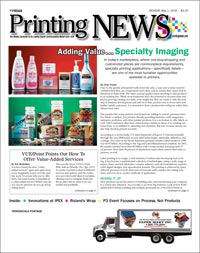|
  May 1, 2006—You have heard the term “value-added services” again and again from every imaginable source over the past few years. Everyone tells you to offer them, but what exactly is classified as a value-added service? Which ones do you choose and how do you go about selling them? May 1, 2006—You have heard the term “value-added services” again and again from every imaginable source over the past few years. Everyone tells you to offer them, but what exactly is classified as a value-added service? Which ones do you choose and how do you go about selling them?
This was the focus of VUE/Point 2006, held in Orlando, Fla., Apr. 10-12. A variety of panels looked at different services and options, and the conference provided solid ideas for printers, offering ways to integrate them into the product mix in order to be successful and profitable.
More than 200 people arrived for the three-day event, now in its 16th year. The agenda kicked off with a keynote by Larry Letteney, co-founder of the Blue Ocean Advisory Group, Wellesley, Mass., and former president of Creo. He set the tone for the event, noting that there are a lot of business areas printers can take advantage of—$831 billion is spent on the total print supply chain each year in the Fortune 100 alone, and only $116 billion of that is actual print. The industry, Mr. Letteney noted, is not dead, it is simply changing, and progressive companies are finding new and innovative ways to make money. “Many of us will fall,” he said, “and many of us will do very, very well.”
He went on to note that in the corporate world, budgets are getting smaller and staffs are shrinking, but there are more products to promote, and larger target audiences to reach. This is a lucrative opportunity for the savvy printer. Instead of focusing on the ROI of a project, only on the costs involved, Mr. Letteney suggested an alternate model, echoed by panelists through the rest of the conference: Return on Communications Investment (ROCI).
The industry is not dead. It is simply changing and progressive companies are finding new and innovative ways to make money.
Instead of going in with print samples and a pitch about your technology or how you can print a brochure better, go in with a notebook and a pencil and be ready to ask questions about a client’s business, their goals, who they want to reach, and how they were considering going about it. Look to build a relationship where print is only one part of the puzzle, Mr. Letteney urged.
Profiling the Modern Printer
In a session titled “Walking the Walk—A Look at Those Who Have Become More Than Just Printers,” the panel was comprised of those who added new technologies and services to their print operations and have seen business thrive as a result. They have gone a variety of routes, from fulfilment services, to digital technologies, to online offerings.
“We’ve seen a lot of change,” said panelist Joe Metzger, president, Metzgers, Holland, Ohio, “and we have to continue to change to stay alive.”
One of the threads that ran through all of the panelists’ businesses was that they looked at how they approached customers and how they sold their services. While each one had a slightly different tactic, the need to redesign the way sales are compensated and how the salespeople are trained was cited as a crucial step to survival. In some cases, staff was retrained to handle both traditional print sales and the new services being added, but in other cases the two were split, with teams dedicated to one or the other.
“Every printer has a niche,” noted Frank Romano, professor emeritus, Rochester Institute of Technology (RIT), Rochester, N.Y. “They may not admit it, or even know it. It could be a class of work, or a class of customer. It has nothing to do with their 40" press, but may involve the number of units, coating, or finishing capability. That niche always involves a salesperson or persons who think out of the box.”
Mr. Metzger noted that at his company they have even trained the customer service representatives (CSRs) to sell, putting them on commission for the services they sell when dealing with clients for such things as Web-to-print offerings. Traditional sales people, he noted, sometimes let small sales slip through the cracks.
A Wide New World
Wide-format printing was the subject of the session “Opportunities in Wide-Format and Inkjet Printing.” Digital print is a fast-growing area of the industry; technology is finally catching up, able to provide quality pieces for a reasonable cost. Having this capability, noted the panel, gives a print shop the ability to offer expanded services to clients.
“The printers who are doing the best have both offset and digital,” said Mr. Romano. “There are some folks who say digital-only printers are growing faster than traditional printers with digital. This is not what you will find when you visit the grassroots.”
Start small and build from there, advised Val DiGiacinto, vice president of technical sales, The Ace Group, New York City. The size of the project is not necessarily in the equipment, but in the finishing and finalizing of the work once it is done, he noted. Print the “must-have-todays” digitally, and run the rest of the job offset, for example. This is one way you can use a digital printer to supplement your current work without much effort.
Another service you can offer without effort is to ask questions, said Steven Amiel, senior vice president, Strategic Content Imaging, Carlstadt, N.J. Ask where the final piece is going and what the environment will be like. Make sure the media will hold up to the environmental conditions, and make suggestions for improvements if you do not think it will work.
Up, Up, and Away
“As printers integrate mailing and fulfillment (M&F), mailing houses are integrating printing—digital printing,” said Mr. Romano.
Competition is getting more and more fierce every year when it comes to adding services, and the line between a mailing house and a printer is getting fuzzier.”
M&F services are a great way to add profit to your bottom line. Frank McPherson, president, Custom Data Imaging Corp., Markham, Ontario, Canada, noted that these services account for 30–40 percent of his revenue, and 60 percent of his profit. As an additional service to print, this is a huge amount of potential work.
According to Bill Kwiatkowski, vice president of manufacturing, Classic Graphics, Charlotte, N.C., the transition to mailing services from printing was easier, although his shop actually started on fulfilment first. They were doing a lot of kit packaging, and were not originally planning to do the mailing. However, once the system for inventory management was put into place, the company realized it could be used for much more; in addition, it made more sense to handle the mailing aspects in-house where they could control costs and quality.
For shops interested in offering M&F services, there are a plethora of resources out there. Education is key, as you will want to know everything you can about this side of the business before offering it to clients. One resource includes the post office, which can point you in the right direction. You can also contact the equipment suppliers and have them come in and evaluate your operations, educate your staff, and work with you on how to build and sell mailing and/or fulfilment programs.
Long Live the King
For the most part, when people talk about value-added services, the first thing that comes to mind is variable-data printing (VDP) and list management. This is the king of additional services, and is fast becoming not just a novelty, but a necessity in today’s world of marketing noise and clutter.
Several sessions at VUE/Point were dedicated to either VDP itself, or its sister service list management. The two go hand-in-hand, since a VDP project is only as good as the customer list used. For printers, this is a great chance to capture more work from clients and make yourself invaluable.
“A few printers are making VDP a commodity by pricing it by the unit or bundling all services at ridiculously low prices,” according to Mr. Romano. “Smart printers have discovered that creating separate database and creative services allows them to price value-added services as value-added services.”
You cannot price VDP as a commodity, as there is far more that goes into it than just the hard paper and ink. The time to design the piece, clean the database, and test everything, for example, is all valuable, and clients should know that premium services carry a premium price.
The print industry is evolving and changing, fast becoming the graphic communications industry. Those who take advantage of that, and who find ways to carve out a niche market, will find themselves in great shape to face the next challenges for years to come.
|


